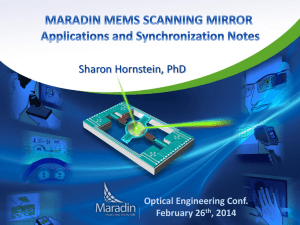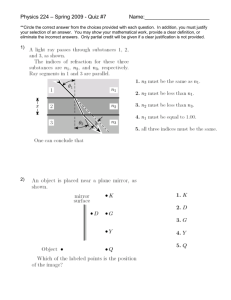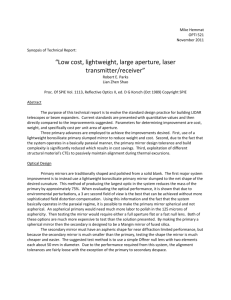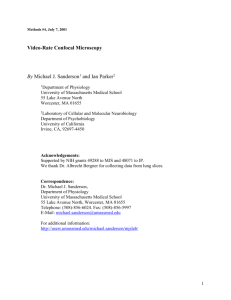confocalScanMicro_new
advertisement
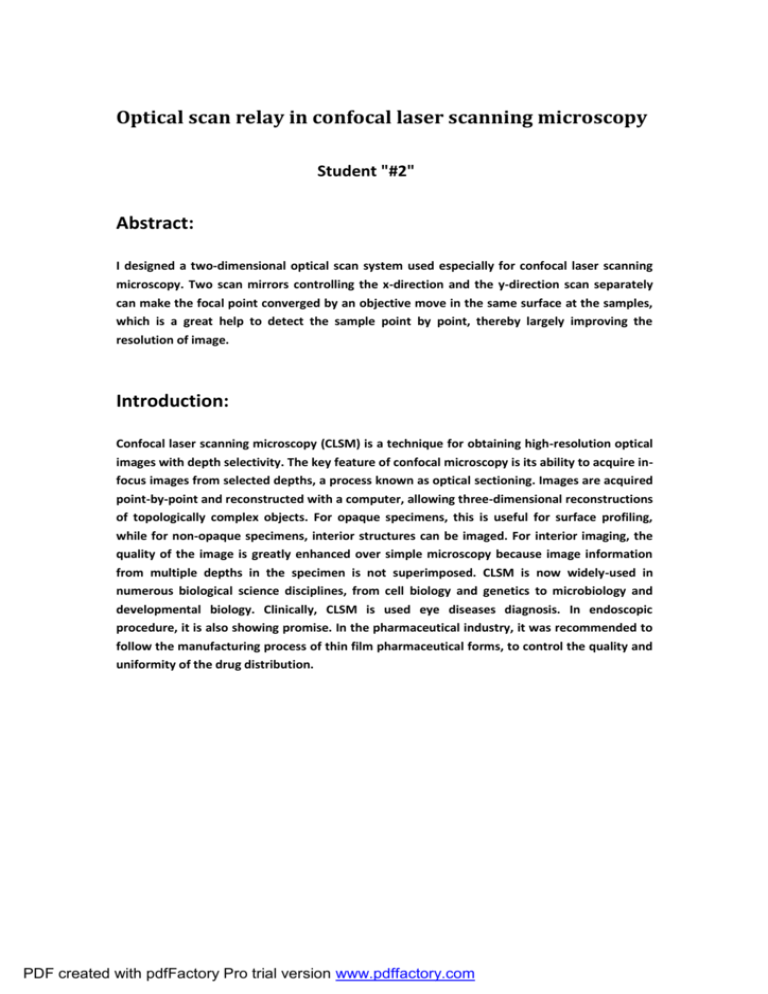
Optical scan relay in confocal laser scanning microscopy Student "#2" Abstract: I designed a two-dimensional optical scan system used especially for confocal laser scanning microscopy. Two scan mirrors controlling the x-direction and the y-direction scan separately can make the focal point converged by an objective move in the same surface at the samples, which is a great help to detect the sample point by point, thereby largely improving the resolution of image. Introduction: Confocal laser scanning microscopy (CLSM) is a technique for obtaining high-resolution optical images with depth selectivity. The key feature of confocal microscopy is its ability to acquire infocus images from selected depths, a process known as optical sectioning. Images are acquired point-by-point and reconstructed with a computer, allowing three-dimensional reconstructions of topologically complex objects. For opaque specimens, this is useful for surface profiling, while for non-opaque specimens, interior structures can be imaged. For interior imaging, the quality of the image is greatly enhanced over simple microscopy because image information from multiple depths in the specimen is not superimposed. CLSM is now widely-used in numerous biological science disciplines, from cell biology and genetics to microbiology and developmental biology. Clinically, CLSM is used eye diseases diagnosis. In endoscopic procedure, it is also showing promise. In the pharmaceutical industry, it was recommended to follow the manufacturing process of thin film pharmaceutical forms, to control the quality and uniformity of the drug distribution. PDF created with pdfFactory Pro trial version www.pdffactory.com Keys for designing confocal Microscope scanning system: Figure 1 The whole confocal microscope system is showed below: In a typical CLSM system, coherent light emitted by the laser system passes through a pinhole aperture that is situated in a conjugate plane with a scanning point on the specimen and a second pinhole aperture positioned in front of the detector. As the laser is reflected by a dichromatic mirror and scanned across the specimen in a defined focal plane, secondary fluorescence emitted from points on the specimen pass back through the dichromatic mirror and is focused as a confocal point at the detector pinhole aperture. Then, figure 2 gives the basic idea of the scanning system in CLSM: X-scan and Y-scan mirror tilt in both vertical and horizontal directions. The coherent light source from laser was scanned in the surface of the specimen in the slide. Figure 2 PDF created with pdfFactory Pro trial version www.pdffactory.com The next are some details about this scan: The optical arrangement was required to produce a linear motion of the illumination spot in the specimen. The image and specimen planes must remain at fixed distances from the objective. So we must use a telecentrical lens system. Any conjugate telecentric plane is an image of the objective telecentric plane. Therefore, in the simplest case, the positioning of a mirror with its pivot point at the center of the objective conjugate telecentric plane produces a one-dimensional beam scanner capable of changing the position of the illuminated spot in the specimen plane as a function of the mirror's pivot angle. So, the mirror forms its image in the entrance aperture of the objective. Then, we apply this concept into two perpendicular axes by adding a second scan mirror. Both of these two mirros should be placed in conjugate telecentric planes, or alternatively, located in close proximity to one another (close-coupled).Various arrangements of scanning system components are possible provided that the primary requirements are satisfied. To ensure diffraction-limited performance of the optical system, the objective rear focal plane (entrance aperture) must constantly be uniformly filled by a planar wave during scanning. Because the physical diameter of this aperture varies with properties of the objective, all other components, including illumination pinholes, must be matched to the objective(s) in use. Conjugate telecentric planes can be produced in required locations by the addition of auxiliary optics, and if this approach is taken, the properties of these must also be carefully considered in regard to their compatibility with the objectives chosen for use with the system. The beam properties of illuminating lasers, in particular the diameter of the Gaussian beam profile, are significant factors in adjustment of pinhole diameter and other variables related to illumination of the objective entrance aperture. Figure 3 PDF created with pdfFactory Pro trial version www.pdffactory.com My design in Zemax: The device parameters in my design are showed in figure4. For simplification, I choose the 4 same lens from Edmund Optics, which was designed to minimize the achromatic aberration, to from two telecentrical imaging systems for the scan process. In my desing, I choose a perfect symmetrical combination of lens, let Fa=Fb=Fc=Fd and Fa’=Fb’=Fc’=Fd’ , so the first scanning mirror image itself at the second scanning mirror, and then the first image of the first mirror and the second mirror was again imaged to the aperture entrance of the objective. The diameter of the entrance aperture was about 6mm to constraint the radius of the laser light passing through the objective, the final field of view in my design is only Figure4 Figure 5 is the 3D image of the scanning system without tilting the laser source. Figure 6 shows the how the beam are moved when the first of the scan mirror are tiled in 3 directions; Figure 7 shows how the second scan mirror worked in 3 directions. Figure 8,9,10 show the spots quality in the image plane, we can see clearly, the spot is fine at 0 degree, but still have aberration when the beam is tilted. We can revise the lens in the system and make them cancel the aberrations, but it would be a time-consuming work, very hard to be fulfilled in this project. Sorry, I did not calculate the resolution of this system because the time is tight, but the aperture diameter and the focal length of the objective constrain the diffraction limits of the system, we can adjust these parameters to reach the best resolution and brightness in the specimen plane. PDF created with pdfFactory Pro trial version www.pdffactory.com Figure5 Figure6 PDF created with pdfFactory Pro trial version www.pdffactory.com Figure 7 Figure 8 PDF created with pdfFactory Pro trial version www.pdffactory.com Figure 9 Figure 10 PDF created with pdfFactory Pro trial version www.pdffactory.com Conclusion: This design meets the basic requirements for a confocal laser scanning microscope. But you can see there still a lot of space for improvement. I don’t consider about minimizing third order aberration in this system, and I did not optimize the size of aperture to get the best brightness and the largest view area in the sample. These problem are also very important in the real practice of confocal laser scanning microscope. PDF created with pdfFactory Pro trial version www.pdffactory.com PDF to Word


